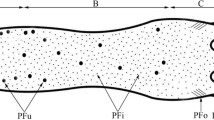Summary
Submandibular glands of adult baboon and Rhesus monkeys were compared after different methods of fixation. In both species, serous acinar cells outnumber mucous acinar cells. In the baboon, serous cells contain secretory granules showing dense cores, moderately dense crescents, and flocculent material. In mucous cells, secretory granules vary in appearance from amorphous to highly ordered depending on fixation. In the Rhesus monkey, serous cells contain the same 3 components of secretory granules as in the baboon. Additionally, a fourth component is represented by a layer of electron-dense material between the crescent and flocculent material. Mucous cells contain electron-dense granules when fixed in Millonig's buffered fixatives, but when Clarke's or Sorensens' buffer is used the granules resemble more typical mucous granules. Duct systems of the two species are similar, but differ mainly in that large foci of glycogen are present in the striated duct cells of the Rhesus monkey.
Similar content being viewed by others
References
Bloom W, Fawcett DW (1975) A textbook of histology. Tenth Edition, W B Saunders Company, Philadelphia, p 48–52
Clark Jr, SL (1963) The thymus in mice of strain 129/J studied with the electron microscope. Am J Anat 122:1–33
Dewey MM (1958) A histochemical and biochemical study of the parotid gland in normal and hypophysectomized rats. Am J Anat 102:243–271
Flon H, Gerstner R (1968) Salivary glands of the hamster I. The submandibular gland: A histochemical study after preservation with various fixatives. Acta Histochem 31:234–253
Ichikawa M, Ichikawa A (1977) Light and electron microscopic histochemistry of the serous secretory granules in the salivary glandular cells of the Mongolian gerbil (Mongolian meridianus), and Rhesus monkey (Macaca irus). Anat Rec 189:125–140
Iqbal SJ, Weakley BS (1974) The effects of different preparative procedures on the ultrastructure of the hamster ovary. Histochemistry 38:95–122
Junqueira LCC (1967) Control of cell secretion. In: (LH Schneyer, CA Schneyer eds) Secretory Mechanisms of salivary glands. Academic Press New York
Kagayama M (1972) The fine structure of the monkey submandibular gland with a special reference to intra-acinar nerve endings. Am J Anat 131:185–196
Leppi TJ, Spicer SS (1966) The histochemistry of mucins in certain primate salivary glands. Am J Anat 118:833–860
Lillie RD, Fullmer HM (1976) Histopathologic technic and practical histochemistry, McGrawHill Book Company New York
Luft JH (1961) Improvements in epoxy resin embedding methods. J Biophys Biochem Cytol 9:409–414
Millonig G (1962) Electron microscopy. In: Proceedings of fifth international congress for electron microscopy, Academic Press, New York
Sabatini DD, Bensch K, Barnett RJ (1963) Cytochemistry and electron microscopy. The preservation of cellular ultrastructure and enzymatic activity by aldehyde fixation. J Cell Biol 17:19–58
Shackleford JM, Wilborn WH (1968) Structural and histochemical diversity in mammalian salivary glands. Ala J Med Sci 5:180–203
Simson JAV (1977) The influence of fixation on the carbohydrate cytochemistry of rat salivary gland secretory granules. Histochem J 9:645–657
Simson JAV, Dom RM (1978) Morphology and cytochemistry of acinar secretory granules in normal and isoproterenol-treated rat submandibular glands. J Microsc 113:185–203
Tandler B, Erlandson RA (1972) Ultrastructure of the human submaxillary gland IV. Serous granules. Am J Anat 135:419–434
Tandler B, MacCallum DK (1974) Ultrastructure and histochemistry of the submandibular gland of the European hedgehog, Erinaceus europaeus L. I. Acinar secretory cells. J Ultrastruct Res 39:186–204
Venable JR, Coggeshall R (1965) A simplified lead citrate stain for use in electron microscopy. J Cell Biol 25:407–408
Watson ML (1958) Staining of tissue sections for electron microscopy with heavy metals. J Biophys Biochem Cytol 4:475–478
Winborn WB (1965) Dow epoxy resin with triallyl cyannurate, and similarly modified araldite and maraglas mixtures as embedding media for electron microscopy. Stain Technol 40:227–232
Author information
Authors and Affiliations
Additional information
Supported in part by NIDR Grant DE05072
Rights and permissions
About this article
Cite this article
Boshell, J.L., Wilborn, W.H. Differences in the ultrastructure of the submandibular glands of baboon and Rhesus monkey revealed by the use of different fixatives. Cell Tissue Res. 231, 655–661 (1983). https://doi.org/10.1007/BF00218123
Accepted:
Issue Date:
DOI: https://doi.org/10.1007/BF00218123




